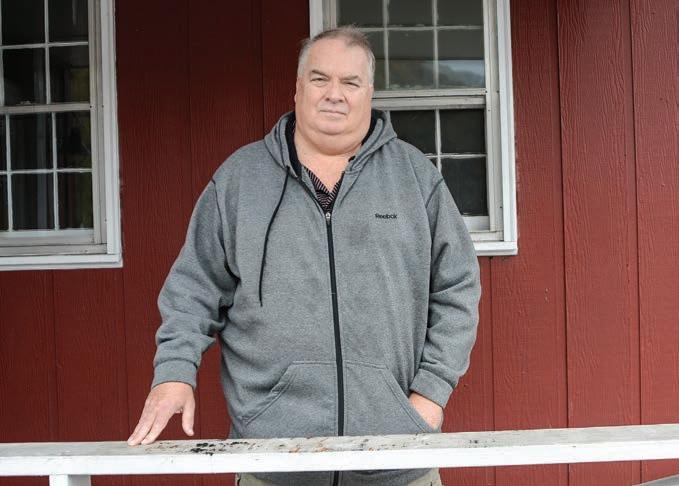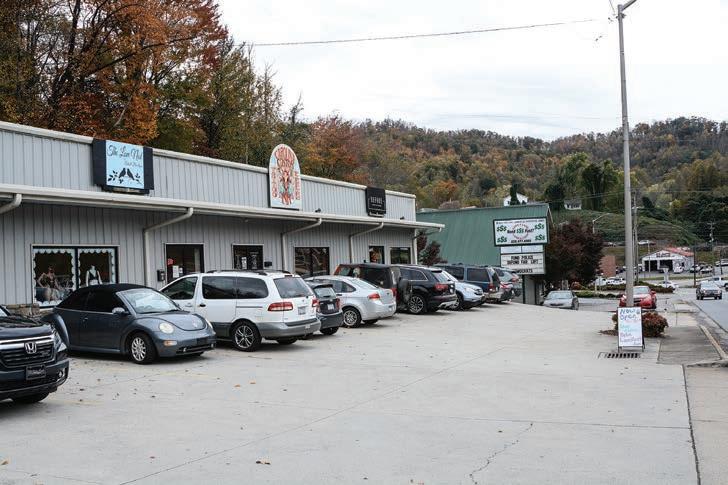
23 minute read
Updated N.C. 107 plans absorb more businesses
Updated plans absorb additional business locations
BY HOLLY KAYS STAFF WRITER
July 15 was a busy Thursday night at Bogart’s Restaurant in Sylva. The dining room was full of people and conversation, the kitchen hopping.
Then came the fire. The grease on the grill ignited, the flames climbing into the hood system. It looked like a big chimney fire, said owner Tim Hall. A volunteer fireman who happened to be dining there saw it and jumped into action, evacuating the occupants. The fire department arrived within two minutes, and while they extinguished the fire, the extensive smoke and water damage left behind meant that Hall would have to rebuild from the studs if he wanted to use the building again.
Two weeks later, Hall got some more bad news. A longtime customer who is also an employee with the N.C. Department of Transportation, told him that the DOT’s plans for N.C. 107 had changed again. Now, the project would destroy Hall’s entire building.
“I’ve never been through anything like this as an owner,” said Hall, clutching the door of one of the sea containers now peppering the parking lot to shield himself from a stiff wind. “I’ve been in business since 1984. And this pandemic, the fire and then the state (road project) is sort of the trifecta. I just couldn’t bounce back from it.”
Bogart’s is one of about nine businesses that recently found out that the N.C. 107 remake would boot them from their buildings. While earlier versions of the plan would have eaten away much of the parking at Bogart’s and at the three buildings skirting the intersection with U.S. 23, also known as Asheville Highway, the buildings were going to stay. But the most recent version of the plans calls for taking the structures too.
For Hall, 62, that made the decision simple — though certainly no less painful. There was no reason to rehabilitate the smoke-damaged building if the DOT was just going to tear it down.
“Having to tell people that, it hurts,” he said. “The worst thing was telling my employees in a meeting. That was the hardest thing.”
Bogart’s Restaurant owner Tim Hall decided to close the Sylva institution after learning — shortly after a grease fire damaged the building — that newly revised N.C. 107 plans would
take down the structure. Holly Kays photo
NEW PLANS RELEASED
The latest changes to the road plan came in September, when the DOT completed its 75% plans for the long-debated road project. While potential remedies for traffic congestion and frequent fender benders on the road have been debated for decades, in 2017 the DOT released an initial concept and concrete path forward for the road project. The remake will extend from West Main Street at the fire department all the way out past Ingles, plus a one-third mile section of the Old Asheville Highway from McDonald’s to the N.C. 107 intersection. The DOT plans to build a five-lane road with a grassy median to replace the existing “suicide lane,” along with bike lanes and improved sidewalks.
Those improvements will require widening the road, which will require purchasing property — and a lot of it. Though the DOT doesn’t have an official number, the road project is expected to require more than 50 businesses to close or relocate.
The DOT expanded that number to include Bogart’s and nearby buildings on the Asheville Highway when further analysis showed the existing road plan would take at least 90% of the properties’ value due to extreme encroachment on parking.
“If you can’t get to the business, can’t get to the structure, you’re going to damage it significantly. The business cannot remain viable,” said Senior Project Engineer Jeannette White. “Looking at that, it just makes sense to say, ‘Let’s go ahead and pay full cost of acquiring those structures.”
Doing so will allow the DOT to consider additional roadway features to improve traffic movement on the corridor. DOT staff came to the conclusion that acquiring those properties would be the best solution just a couple weeks before the fire at Bogart’s, said White. The agency made sure to let Hall know about those discussions before he pulled the trigger on renovations to the damaged building.
A review of the plans also caught an error in which road designers failed to look at peak volume traffic when designing the right turn lane for Dunkin’ Donuts. That meant that, as written, the plans would not alleviate backups into the main lanes during those peak times. Now, the plans include free-flow lanes that encroach on the existing Dunkin’ Donuts building. The business plans to relocate on the same parcel to accommodate the project, White said.
A BLOW FOR NEW BUSINESSES
For other entrepreneurs on the strip, the news came at a much different time in the life of their business.
“It’s posed some concerns for us, because we’re afraid to move to any of the other locations that have a high traffic visibility area, because they are eventually going to get moved,” said Angela Zoran of Imperial Security and Wiring. “Even if they’re told, ‘We’re only taking your parking lot,’ apparently that is not in stone.”
Zoran and her husband Mark moved into the gray Asheville Highway strip mall owned by Kole Clapsaddle in April, spending more than $30,000 to renovate the space and set it up as a showroom for their home automation business. They’d operated the business out of their house for years, but finally decided to pull the trigger on a public storefront, hoping to gain more visibility in town.
Just a couple months later, they learned that their new location was slated for destruction, and that because they’d been in the space for less than two years, they’d receive fewer benefits than if they been there longer. Now, Zoran is not sure they’ll even stay in Sylva. There are only so many business locations in town, and the ones with the highest traffic visibility are the ones most vulnerable to the road project.
Alicia Buckley of The Sylva Love Nest is in a similar situation. She and her husband David opened the store in June. The couple also own The Pied Piper, which is located in another one of Clapsaddle’s properties. When the Asheville F





HaywoodBuilders.com 100 Charles St. WAYNESVILLE
Newly revised road plans will take out this strip mall on the Asheville Highway, as well as the green-roofed building below it that contains Liberty Tax Service, among other businesses.
Holly Kays photo
Highway space came available, they jumped on it.
“It’s a great location,” she said. “All of a sudden, a month and a half, two months into it, I found out that this building is going to go too. It was definitely a surprise. It’s a bummer.”
Unlike Zoran, Buckley does have somewhere to go — a business behind Zaxby’s, whose space is also owned by Clapsaddle, plans to leave. The landlord has offered her a place there. Regardless, it’s a loss. Though she didn’t put near the money into her store that the Zorans did, she did incur some cost. She’ll miss the current location’s high visibility, and she’s worried about how the road project will affect the town as a whole.
“What is the overall commerce in Sylva going to look like?” she said. “Are they going to rip up everything? Is it going to be a ghost town? It’s unnerving.”
THE NEW TIMELINE
The design and timeline for the pivotal project have changed multiple times since the first concrete plans were released in 2018. At that time, the DOT estimated the work would be done by 2022 and cost $35.5 million.
Now it’s the end of 2021, and right-of-way acquisition has only just begun. Construction isn’t expected to start until the second half of 2024. Estimated costs continue to increase, with figures calculated on June 10 placing the total cost at $116.1 million, of which $56.2 million is for construction, $52.7 million for right-of-way, and $7.2 million for utilities. The estimate represents a 7.8% increase over previously released figures, White said.
Though there are still three years to go before construction, the DOT wants to see the right-of-way acquisition process wrap up in two years. It’s contracting with Charlottebased TELICS to manage the right-of-way phase, which began in July.
To Zoran, the recently announced changes at the N.C. 107 and U.S. 23 intersection show that no plan is final and that even properties declared safe from the road project can be gobbled up at any time. But White said that acquisitions outlined in the 75% plans are “pretty much set in stone” — with one exception.
Plans could still shift on both sides of the roadside corridor from Pizza Hut to the Lowe’s entrance depending on what the DOT decides to do about Mill Creek. When the road was widened in the 1980s, the DOT encased the creek in 6-foot pipes and buried it under the road. Current standards require two 6-foot pipes to route the stream, not just one, but making that change would significantly impact businesses located close to the roadside. The design team is considering rerouting the stream to flow along the backside of the properties instead. White hopes to have a more definitive plan by next summer.
Other than that, she said, the 100% plans shouldn’t include any changes to acquisition plans compared to the 75% version. Remaining issues to work out mostly involve decisions about pavement marking, traffic management, erosion control and traffic flow. Additionally, final plans will include a bridge realignment and potential refurbishments to another bridge.
While the project will be painful, said White, she believes it will ultimately benefit the town by creating a safer and more sustainable roadway.
“During the process and during construction it is painful, but it is in my opinion the right thing to do for the safety of the community,” she said.
In previous years, there may well have been a loud chorus of opposition to such a statement. Charlie Schmidt, general manager for Sylva institution Speedy’s Pizza, was one of the loudest voices in those discussions, but he said he’s now shifted to general acceptance that the project — and the destruction of the building that’s housed Speedy’s for more than three decades — is inevitable.
“The time to stop it or fight it is obviously long gone,” he said. “Something’s going to happen, so we just gotta figure out the best way to move forward.”
Ingles Nutrition Notes
written by Ingles Dietitian Leah McGrath
Question: What are some “superfoods” that you Would recommend?
ansWer: The term “superfood” is a clever marketing term to draw attention to a specific food to enhance or increase visibility, awareness and consumption(sales). Over the years we've seen lots of different foods referred to as “superfoods” — pomegranate juice, acai berries, wild caught salmon, kale, spinach, Greek yogurt — to just name a few. Classifying an item as a “superfood” creates an opportunity for that food to be highlighted on cooking shows, blogs and in magazines, to cost a bit more at the supermarket and to have it included in other items, e.g. pomegranate tea, kale chips, acai berries in cereal. In fact, we could find something “super” about most any food from beans to beef and from tea to turnips based on macro and micronutrients! Focusing on what we eat in our meals and across the whole week is a better way of improving our nutrition and our health rather than just worrying about trendy “superfoods”.
Leah McGrath, RDN, LDN
Ingles Market Corporate Dietitian @InglesDietitian Leah McGrath - Dietitian 800.334.4936



Haywood Chamber celebrates 50 years of development, engagement
BY CORY VAILLANCOURT POLITICS EDITOR
It’s not the first thing people usually think of when they try to recount the relative prosperity of a community over generations.
Usually, it’s the politicians, the policies and the personalities behind the progress that get the headlines, but oftentimes underlying them all is an ancient institution that everyone knows about, but few truly know: the local chamber of commerce.
As a voluntary association of businesses advocating for interests that ultimately intersect with the public good, modern chambers of commerce can be said to engage in the business of development — of both the local economy and the people who support it.
For the past 50 years, the Haywood County Chamber of Commerce has been a central part of that effort and is responsible for millions in investment and thousands of jobs.
But with 50 years of lessons learned, the Haywood chamber remains intent on developing the leaders who will learn from those lessons and apply them to the next 50 unpredictable years.
While chambers of commerce are now ubiquitous — there are more than 13,000 across the world and at least 4,000 in the United States alone — it wasn’t always that way.
Chambers of commerce trace their roots to medieval trade guilds that acted to regulate trade and to interface with other guilds in promoting businesses in a specific town, county or region.
The first true Chamber of Commerce was founded in Marseilles, France, in 1599 when the municipal government found it could no longer manage both civic and commercial affairs at the same time.
According to The Magicians of Main Street, a comprehensive history of America’s chambers of commerce written by Chris Mead in 2014, the Chambre du Commerce de Marseille was involved in harbor maintenance, commissioning trade delegations and even roving pirate abatement.
Almost three centuries later, the Chambre du Commerce would play a critical role in building the Suez Canal. The canal, which would revolutionize maritime trade across Europe, wasn’t the first example of a chamber of commerce intervening in such big-picture business issues; a chamber founded in Paris shortly after the one in Marseille gave critical backing to Samuel de Champlain as he pushed for growth in the infant settlement of French Canada during the 17th century.
America’s first chambers of commerce were founded just before the American Revolution, in New York and Charleston, South Carolina, although similar groups had existed in Boston since the 1730s. After a brief interregnum owing to the war, chambers of commerce began to spring up across this new nation, in places like New Haven and Hartford, Connecticut, and Lexington, Kentucky.
Chamber creation boomed during the 1800s as major commercial centers (usually with ports) like Savannah, Georgia, New Orleans, Chicago and Detroit established their own.
Wilmington became the first chamber of commerce in North Carolina in 1853, followed by New Bern in 1866, Charlotte in 1870, Greensboro in 1877, Winston-Salem in 1885, Goldsboro in 1887, Raleigh in 1888 and Asheville in 1898.
Mead’s book relates an interesting anecdote regarding Asheville’s chamber that illustrates the many areas in which chambers of the time worked to promote commercial interests within their jurisdictions.
In 1927, a man visiting the town complained about the lack of “old-time music” and was then encouraged to bring some musicians to the Asheville chamber’s Rhododendron Festival.
That man was legendary Appalachian fiddler Bascom Lamar Lunsford, and with him were the Soco Gap Square Dancers — a Maggie Valley group led by Haywood County’s own Sam Love Queen credited with introducing clogging to the world.
The first known mention of any local chamber of commerce west of Asheville comes in the Feb. 3, 1921, issue of The Carolina Mountaineer and Waynesville Courier. According to the story, an evening rally hosted by the Canton Chamber of Commerce kicked off late because guests coming in from Asheville got their car stuck in the mud.
At some point around this time, the Canton chamber merged with the Bethel Chamber of Commerce to become the Canton-Bethel Chamber of Commerce.
Over the ensuing decades, separate chambers were established in Clyde and Waynesville, which served areas from Balsam to the edge of Clyde.
The Maggie Valley Chamber of Commerce’s Facebook page says it was established in 1963, but newspaper reports place its founding decades earlier than that. By the early 1970s, the larger, more professional chambers had begun talks on consolidation, to take advantage of economies of scale and promote the county as a whole, rather than as individual slivers of competing economies.
On Jan. 12, 1971, the Waynesville Area Chamber of Commerce changed its name to the Greater Haywood Chamber of Commerce, in anticipation of a consolidation with Clyde and Canton-Bethel.
At the same time, the respective boards of directors led by Canton-Bethel president L.A. Coman, Jr. and Greater Haywood president W.H. Anderson unanimously approved a study geared toward achieving unification.
In the fall of 1971, that unification became a reality, bringing together all but the Maggie Valley chamber under one banner.
“It is going to mean work, understanding and cooperation,” reads an editorial in the Oct. 4, 1971 issue of the Waynesville Mountaineer. “And what is hard about any of the three? Haywood has been, and still is, the envy of many counties. We think it is largely because we strive to work together and attain success in outstanding programs.”
Today, the Haywood Chamber of Commerce continues that work on a budget of less than $200,000 a year, not quite double that of the 1971 Waynesville chamber’s inflation-adjusted $123,000. Although chamber membership fluctuates, it’s usually in the range of 400 to 500 businesses.
Most of the Haywood chamber’s revenue comes from dues, sponsorships and events. The Apple Harvest Festival is the biggest and will next year celebrate its 35th anniversary. There’s also a yearly golf tournament and an annual dinner.
Other revenue comes from a plethora of programs designed not as revenue generators but instead as community networking events intended to encourage the next generation of Haywood County’s commercial and civic leadership.
There’s a group called Young Professionals of Haywood that meets on a regular basis, as well as a group headed by local entrepreneur/writer Wendy Forbes, called Women Enlightened. A monthly Issues and Eggs series brings in regular speakers to keep the community apprised of important topics in the region, and the yearly Leadership Haywood program provides 9 months of intensive instruction with a local focus on topics as varied as history, the environment, economic development, law enforcement and state and municipal government.
But the Haywood chamber’s development into a community-wide resource didn’t just happen overnight; instead, for nearly two decades, it’s been nurtured under the watchful leadership of a transformative figure in the history of Haywood County’s own development. F

Longtime Haywood Chamber President Cece Hipps speaks at a recent 50th anniversary
gathering. Cory Vaillancourt photo
The Greater Haywood Chamber’s logo,
circa 1972. File photo
Following devastating August flood, BearWaters Brewing reopens
BY GARRET K. WOODWARD STAFF WRITER
Sitting at a picnic table on the banks of the Pigeon River in downtown Canton, Kevin Sandefur turns around and points to the high-water line on the side of the BearWaters Brewing building.
“Just below the big windows right there,” said Sandefur, co-owner of the brewery, in a humbled tone. “The water just didn’t stop rising — I thought we had lost everything we’d worked so hard to build.”
That waterline is several feet above the parking lot, the basement of the facility filled to the brim with slippery mud, silt and water. Unless you witnessed it first-hand, it’s hard to imagine how violent and widespread the ravaging floodwaters of Tropical Storm Fred were when it overtook the small mountain town and other parts of Haywood County on Aug. 17.
“It was almost like a dream, but more so a nightmare,” Sandefur said. “With any kind of disaster that you’re part of, it starts to unfold and it seems surreal because you feel so helpless. We thought we had the flooding under control and then, just a few moments later, the river is over the banks and it’s climbing quickly.
Now it’s fall and the doors of BearWaters are once again open, the cold ales pouring from the taps and hot food coming from the kitchen. It’s been a herculean effort to remove all the mud and debris from the property and rebuild, this seemingly neverending task of mankind versus the wrath of Mother Nature.
“The reopening should have probably taken three more months to do the repairs. But, the first five days after the flood was so incredibly crucial with all of the volunteers who showed up,” Sandefur marveled. BearWaters co-owner Kevin Sandefur. “There’s no way we’d be open here today if it wasn’t for the volunteers who (photo: Margeaux Boles) showed up from all over to help us clean up and get back on our feet.” The morning of Aug. 18, with the sun out and floodwaters slowly receding, Sandefur and his staff returned to the brewery to inspect the damage. What they found was a war zone of materials and mud. Kegs and cans strewn in every direction, most filled with product now deemed unusable. Of what product could be salvaged, Wicked Weed Brewing stepped in and picked up the numerous kegs to be housed in its Asheville cold storage facility until BearWaters was able to start pouring again. Sierra Nevada Brewing Co. also lent a hand by coming in to aid in equipment that was in need of immediate repair. And when the cleanup began, hundreds of volunteers stepped onto the property, offering services from simply shoveling mud to expert skill sets in electrical, plumbing and structural engineering. “We had people taking time off from work to come and pressure wash the walls. Everyone was working to get something

From her desk inside a handsome 1920sera Waynesville mansion on Walnut Street, Haywood Chamber of Commerce President CeCe Hipps has guided the chamber through some of its most challenging periods.
Hipps arrived in 2004, shortly before devastating floods ravaged the county. Four years later, in 2008, a recession borne on the back of a bursting bubble in the housing market ensued. More than a decade after that, as the economic damage from the Great Recession was finally in the rear-view mirror, a once-acentury global pandemic shuttered businesses across the country. The next year, another devastating flood.
Still, Hipps’ Haywood chamber has scored some important victories over those 17 years, in conjunction with the late Mark Clasby’s economic development expertise.
“Definitely the Dayco project — turning that into a mega-retail center for us,” Clasby told The Smoky Mountain News in August 2017. “Phase one was the Walmart and the Best Buy, and phase two was the Belk’s, Michael’s and PetSmart. They’ve been very successful.”
In late 2017, the Haywood chamber and the Haywood Economic Development Commission entered into an innovative partnership with the much larger (and older) Asheville chamber to approach economic development in concert, rather than in competition.
“The Haywood Chamber of Commerce really exists to be a resource, a catalyst for growth and economic development among the business community here in Haywood County,” said Dr. Michael Coleman, chair of the Haywood Chamber of Commerce’s board of directors since this past July. “Economic development and the chamber go in tandem with one another.”
The partnership leverages the cache of trendy, well-known Asheville for the benefit of its lesser-known neighbors in Haywood County; economic development sites in Haywood are marketed alongside those in Buncombe.
While producing a noticeable uptick in the amount of interest in Haywood among national and international companies, the partnership has also resulted in two notable victories from right here in Western North Carolina.
“Small business, for example, is so important to our economy both nationally and here locally,” Coleman said. “We need to make sure on a continual basis that our local elected officials understand that and continually strive to help this area and help our surrounding areas with growth and economic development opportunities.”
One is the expansion of Frog Level’s Giles Chemical, which Hipps said had been exploring an expansion outside the region.
“The other is [Franklin-based] Drake Software, which was about a three-year process,” Hipps said. “We’ve been working on Drake for a long time, which is a really good thing for us.”
In the field of economic development, the mantra is simple — grow or die.
Growth requires consistent, coherent messaging to state and federal leaders. In fact, one of the newly-merged chamber’s efforts in 1971 involved lobbying the state for an additional vehicle tag facility in Waynesville to augment the county’s only office in Canton. Another, throughout the 1970s, focused on improving local roads as an expedient to commercial and recreational activity.
That cooperation endures, as local businesses and municipal governments continue to navigate the state and federal processes associated with flood recovery. Simultaneously, Coleman said that because of the Coronavirus Pandemic, the Haywood chamber has been taking the time to reevaluate nearly every aspect of its operations to done — getting the mud out or moving equipment,” Sandefur said. “It definitely verifies what we had hoped for when we opened here. That we’re not just a brewery or a restaurant, but it’s a community center for people that come here — it means that we’re truly part of Haywood County.”
In a sort of twisted irony, BearWaters was awarded the “Business of the Month” by the Haywood Chamber of Commerce during the period in which it was closed and under construction due to the flooding. The award itself was already decided before the storm rolled through Western North Carolina.
And yet, the award itself is a testament to the brewery, to the vision Sandefur set out to accomplish some 10 years ago with an $8,000 chamber seed grant and a deep love for craft beer and brewing that’s only grown and blossomed since then.
“It’s all been incredibly overwhelming and humbling. It’s all of these things that let you know that care about your brewery and what it means to the community,” Sandefur said.
Getting up from the picnic table and making his way back to the brewery, Sandefur readies himself for the afternoon rush of customers that usually wander in come 5 o’clock. What was once, perhaps, a whirlwind of people and drink/food orders is now a buzz of humanity — old friends and new — that Sandefur & Co. will never take for granted.
“Sure, you can sell beers and you can sell hamburgers all day long. But, there’s an intrinsic value that exists now that is beyond anything we could make or sell,” Sandefur said. “One of the most powerful statements said to me was, ‘We need you guys to survive.’ It was crazy to hear that — it’s very rewarding to know you’ve built something that people care about.”
ensure they are and will continue to be relevant in a world forever changed by COVID-19.
Into that world heads the Haywood chamber, presumably for another 50 years, and more beyond that. Based on the calamities Hipps has had to weather during her time here — as well as those victories — the chamber of the future needs to be prepared for any economic eventuality.
“I don’t have a crystal ball, but there’s always a vision going forward of what you want to achieve in a community,” she said.
Workforce development is a key component of that, says Hipps, and creating quality jobs is an essential goal for this tourism-based service economy that experiences a good amount of “brain drain” — young, educated people forced to leave the county or region due to a lack of opportunity befitting their credentials and experience.
“I think we need to continue to develop leaders within the community. That’s why I started the Young Professionals, the Women Enlightened, the Leadership Haywood program — to grow and develop these young leaders and provide them with the opportunity to get engaged with the community,” she said. “Because engagement in the community is where the leaders come from.”







